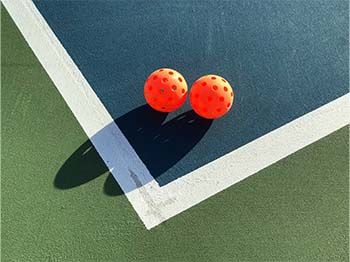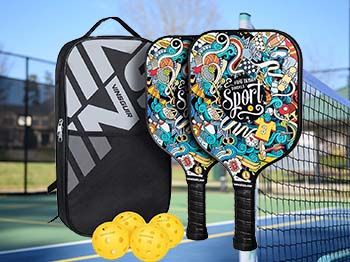Avoid These Pickleball Mistakes and Improve Your Game!
Pickleball, like any sport, is an art form. Craftsmanship, precision, and strategy are required to become the best player possible. As with any skill, mastery starts with the basics. Whether you are new to the game of pickleball or a seasoned veteran, perfecting the fundamentals is paramount to taking your game to the next level.
At Active Aging, we are dedicated to helping aging adults increase vitality, maintain longevity, and simply feel better. We accomplish this by partnering with the nation's top health and fitness experts. Recently, we were lucky enough to interview Robert Leonard, one of Colorado’s leading pickleball instructors at Gates Tennis Center. Robert grew up in San Diego with a strong background in tennis and paddle tennis before finding and falling in love with our favorite fast-paced, strategic sport: pickleball. He began teaching in 2020 in Santa Barbara and has had the pleasure of teaching Kenny Loggins. He currently teaches full-time at Gates Tennis Center in Denver, CO. He plays with JOOLA paddles and competes at the 5.0 and Open Pro level in singles and doubles.
Pickleballers, ye be warned, these are crucial errors to avoid. Mastering these tips guarantees immediate improvement. Remove these fixable mistakes to sharper your craft, become more competitive, and let your game speak for itself!
Don’t Take Your Eye Off The Ball
“Don’t take your eye off the ball.” We’ve heard it a thousand times in countless different sports. It seems like an obvious tip. But why is it so important? It’s actually quite simple. Taking your eye off the ball isn’t just about missing a shot; it can make the difference between a foul and an ace. Even the pros practice this simple tip tirelessly to minimize a mishit in a big moment.
Identifying Your Dominant Eye is a Good Starting Point
Have you ever wondered which is your dominant eye? Knowing this information is helpful in all sports, especially pickleball, because it improves focus and accuracy. So, how do you find out which is your dominant eye? Hold your racket in front of you with both eyes open. Point the racket at a target about ten feet in front of you and then close each eye, one at a time. Whichever eye keeps the racket closest to the target is your dominant eye.
Watch Your Paddle Hit the Ball
Every SINGLE time you hit the ball, watch your paddle come through and make contact. Consider this the golden rule of pickleball! Additionally, avoid the temptation of looking where you want the ball to go to reduce the chance of a mishit. Lastly, aim smack in the middle of the sweet spot of your paddle for the best hit possible, and compensate for a spin. If you do these tips, we guarantee your hitting will already improve.
Keep a Strong Ready-Position
Your reaction time is considerably slower when you are unprepared to hit the ball. Professional players are trained to maintain a strong ready-position on each shot, not just the first shot. The pros are also taught proper ready-position form. So, how should your ready-position look?
How Should Your Ready-Position Look in Pickleball?
Although pickleball is a paddle sport, the game starts from the waist down. This means your legs should be bent at the knees when in your ready-position. You should also stand on your toes and avoid leaning back into your heels. A common mistake among amateur players is having “t-rex arms.” This occurs when your arms are not extended far enough in front of your body. Thus, it’s important to keep your arms extended out over your toes with your paddle held shoulder high. Avoid dropping your paddle to your waist, as this is easy to do when your arms tire. Lastly, keep your eye on your opponent and do not become distracted by your surroundings.
Returning to the Ready-Position
You should return to the ready-position after every shot. Amateur players tend to have a strong ready-position when preparing to return a serve; however, their form often deteriorates on the subsequent shots. Each
When Should You Hit a Forehand vs. Backhand?
Watch nearly any amateur pickleball match, and you will see ample poor shots and mishits due to players using the wrong hand. So this begs the question, forehand or backhand, which shot should you hit and when? The answer is relatively straightforward. If you are a right-handed player, only hit a forehand when the ball is on the right side of your body. If you are a left-handed player, only hit a forehand when the ball is on the left-hand side of your body. The word only is critical here. That’s because shots in the center of your body should be struck with a backhand, never a forehand. Too often, amateur players attempt to hit shots in the center of their body with a forehand, leading to mishits. Implement this one tip, and your game will improve immediately.
Proper Weight Distribution
The next pickleball mistake is related to footwork. You always want your weight on your toes and moving forward. Be mindful to constantly step into your shots, even if it means playing a little farther back on the court. You don’t want to move backward or shift your weight onto your heels, consequently removing all the power out of your shot.
Never Backpedal
Never backpedal to retrieve balls hit over your head. Not only is backpedaling bad form, but it's a safety issue, as you can trip over your feet. It’s better to move sideways by shuffling your feet, allowing for better form and quicker footwork.
Keep the Ball in Play
If you reduce pickleball to its lowest denominator, one rule will make you a winning player: you win the point by being the last player to keep the ball in play. Too often, points are lost by players trying to attempt difficult shots in situations they should just keep the ball in play. For example, if you receive a high ball and have the opportunity to slam it, then hit it in the middle of the court. You will hit the ball out of bounds if you try to slam it in the far corner. High-percentage shots pay off, so let your opponent make the mistakes.




